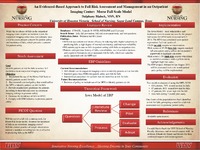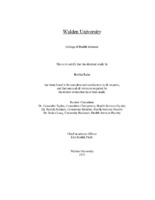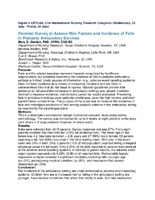| dc.contributor.author | Blalock, Dalphany | en |
| dc.date.accessioned | 2016-03-21T16:33:04Z | |
| dc.date.available | 2016-03-21T16:33:04Z | |
| dc.date.issued | 2016-03-21 | |
| dc.identifier | CONV15RS1.12 | en |
| dc.identifier.uri | http://hdl.handle.net/10755/602618 | |
| dc.description | <p>43rd Biennial Convention 2015 Theme: Serve Locally, Transform Regionally, Lead Globally.</p> | en |
| dc.description.abstract | <p>Session presented on Saturday, November 7, 2015 and Sunday, November 8, 2015:</p>
<p><strong>Purpose:</strong> The purpose of this evidenced-based project is to explore the use of the Morse Fall Scale (MFS) risk assessment tool as an intervention to decrease patient falls in an out-patient imaging center. Significance: Falls pose serious consequences to patients, healthcare providers, and society in general, as they lead to serious injuries such as head trauma, fractures, and even death (Johnson, et al., 2011). In addition to the physical impact on the patient's overall well-being and their families, there is an enormous financial burden to them and society in general. Direct medical care costs imposed on healthcare organizations is forecasted to reach an excess of $43 billion dollars by year 2020 (Johnson et al., 2011). Added to that mix is the Institute of Medicine's (IOM) initiative for patient safety.</p>
<p><strong>Literature review:</strong> A literature review using systematically reviewed data (Level I/II) was implemented to determine best practices for reducing fall incidences in an out-patient imaging setting.</p>
<p><strong>Results:</strong> After two months of using the MFS, 550 patients were examined and 416 of those patients, 76% of the population, scored a zero risk for falls. However, 87 patients, 16% scored low risk, and 47 patients, 9% scored high risk for falls. In that initial two month assessment, one-fourth of the patient population assessed is at risk for falls, implicating a need for a standard tool to assess for falls and a policy and procedure to reduce falls and promote safety.</p>
<p><strong>Conclusion:</strong> Will continue to monitor for fall risk for six months and implement a policy based on the efficacy of the Evidence-based practice project.</p> | en |
| dc.format | Text-based Document | en |
| dc.language.iso | en_US | en |
| dc.subject | Fall Incidences | en |
| dc.subject | Outpatient Imaging | en |
| dc.subject | Morse Fall Risk Scale | en |
| dc.title | An evidenced-based approach to fall risk assessment and management in an outpatient imaging center: Morse Fall Scale | en |
| dc.type | Poster | en |
| dc.rights.holder | <p>
All rights reserved by the author(s) and/or publisher(s) listed in this item record unless relinquished in whole or part by a rights notation or a Creative Commons License present in this item record.
</p><p>
All permission requests should be directed accordingly and not to the Sigma Repository.
</p><p>
All submitting authors or publishers have affirmed that when using material in their work where they do not own copyright, they have obtained permission of the copyright holder prior to submission and the rights holder has been acknowledged as necessary.
</p> | en |
| dc.description.note | <p>Items submitted to a conference/event were evaluated/peer-reviewed at the time of abstract submission to the event. No other peer-review was provided prior to submission to the Henderson Repository, unless otherwise noted.</p> | |
| dc.type.category | Full-text | en |
| dc.evidence.level | N/A | en |
| dc.research.approach | N/A | en |
| dc.contributor.department | Phi Chi | en |
| dc.author.details | Dalphany Blalock, RN | en |
| dc.conference.name | 43rd Biennial Convention | en |
| dc.conference.host | Sigma Theta Tau International | en |
| dc.conference.location | Las Vegas, Nevada, USA | en |
| dc.date.conferenceyear | 2015 | |
| dc.description.reviewtype | None: Event Material, Invited Presentation | en |
| dc.description.acquisition | Proxy-submission | en |





